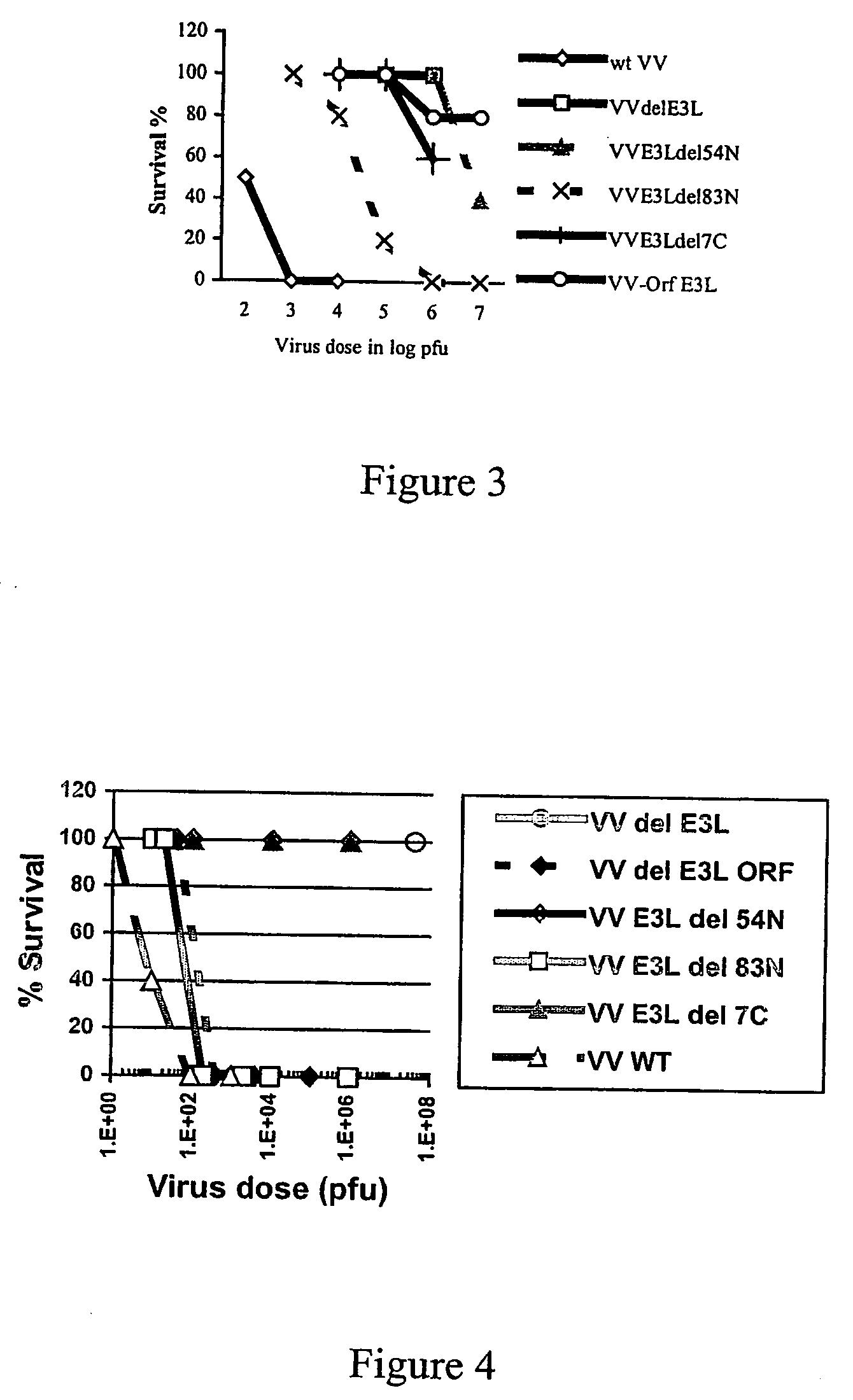Mutants of replication competent vaccinia virus
a technology of vaccinia virus and mutants, which is applied in the field of vaccinia virus mutants, can solve the problems of drug-dependent viruses being rendered incapable of continuing replication and severe complications, and achieve the effect of relative immunogenicity and safety
- Summary
- Abstract
- Description
- Claims
- Application Information
AI Technical Summary
Problems solved by technology
Method used
Image
Examples
example 1
Engineering of vaccinia Virus Containing Mutations in the E3L Gene
[0060] Over 50 strains of VV containing mutations in the E3L gene have been prepared. Mutations are generally prepared by transient dominant selection, using the ecogpt gene as the transient selectable marker. Plasmid containing mutations in the E3L gene are used to perform homologous recombination with viruses containing an E3L gene replaced by lacZ, transiently selecting for resistance to mycophenolic acid (selection for ecogpt), and then screening for loss of staining with X-gal (replacement of lacZ by the gene of interest). Alternatively, virus that has incorporated a wild type E3L gene can be selected for by growth on Vero or MRC-5 cells (virus deleted for E3L does not replicate in Vero or MRC-5 cells). All viruses are assayed by PCR for the correct insertion, for the correct phenotype in cells in culture and by sequence analysis of the inserted gene.
example 2
Safety
[0061] The present inventor has previously tested strains of VV for safety and efficacy in mouse model systems. Most of this work has been done with viruses containing mutations in the VV E3L gene and demonstrates an ability to engineer numerous strains of VV and to test them for safety, in both immune competent and immune deficient mice, and for efficacy as vaccines in a mouse challenge model.
[0062] Although a subset of the examples relate to viruses containing mutations in the E3L gene, the Examples are included to illustrate the materials and methods that may be used to generate and assay the activity of recombinant viruses of the invention.
[0063] Four mouse models have been used to assay for safety of engineered strains of VV: intra-nasal (I.N.) and intra-cranial (I.C.) infection of C57B16 mice, intra-nasal infection of Balb / c mice and intra-nasal infection of SCID mice. The LD50 of wtVV-WR in these models is as follows:
Type of infectionLD50 (pfu)wtVV-WR / intra-nasal / C...
example 3
[0065] The C57B16 and Balb / c challenge models have been used to test for efficacy of putative vaccines. The Balb / c model has the advantage that wtVV-VVR causes mortality after I.N. infection in 8 week old mice, while in the C57B16 model, mice get sick and loose weight but do not die. Groups of four week old mice are vaccinated either I.N. or by scarification, and monitored for symptoms of the vaccine (weight loss, morbidity; formation of skin lesions for scarification). After four weeks, mice are challenged I.N. with a large dose (106 p fu) of wtVV-WR and monitored for weight loss, morbidity and death (Balb / c). Vaccination afforded a dose dependent protection against weight loss induced by the wtVV challenge and afforded protection against death in Balb / c mice (data not shown). Protection was obtained with a lower dose of virus I.N. (103 pfu) than by scarification (106 pfu, data not shown)
PUM
| Property | Measurement | Unit |
|---|---|---|
| temperature | aaaaa | aaaaa |
| weight loss | aaaaa | aaaaa |
| concentration | aaaaa | aaaaa |
Abstract
Description
Claims
Application Information
 Login to View More
Login to View More - R&D
- Intellectual Property
- Life Sciences
- Materials
- Tech Scout
- Unparalleled Data Quality
- Higher Quality Content
- 60% Fewer Hallucinations
Browse by: Latest US Patents, China's latest patents, Technical Efficacy Thesaurus, Application Domain, Technology Topic, Popular Technical Reports.
© 2025 PatSnap. All rights reserved.Legal|Privacy policy|Modern Slavery Act Transparency Statement|Sitemap|About US| Contact US: help@patsnap.com



